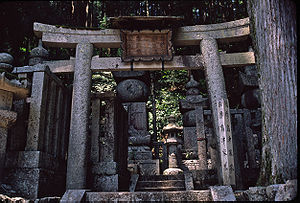Shimazu clan

Shimazu (島津) was the family name of the daimyō of the Satsuma han, which spread over Satsuma, Ōsumi and Hyūga provinces in Japan.
The Shimazu were descendants of the Seiwa Genji branch of the Minamoto clan. The founder, Shimazu Tadahisa (d. 1227), was a son of Shogun Minamoto no Yoritomo (1147-1199) with the sister of Hiki Yoshikazu. Tadahisa's wife was a daughter of Koremune Hironobu, descendant of the Hata clan, whose name Tadahisa took at first.
He received the domain of Shioda in Shinano province in 1186 and was then named shugo of Satsuma province. He sent Honda Sadachika to take possession of the province in his name and accompanied Yoritomo in his expedition to Mutsu in 1189. He went to Satsuma in 1196, subdued Hyūga and Ōsumi provinces, and built a castle in the domain of Shimazu (Hyuga) which name he also adopted.
The Shimazu would become one of the families of Edo period daimyō to have held their territory continuously since the Kamakura period, and would also become, at their peak, the wealthiest (most powerful) tozama family, with an income in excess of 700,000 koku.
The 19th head, Yoshihiro (1535–1619), was the daimyō at the time of the Battle of Sekigahara, the establishment of the Tokugawa Shogunate, and the Siege of Osaka. His nephew and successor, Shimazu Tadatsune, however, held significant power during the first two decades of the 17th century, and organized the Shimazu invasion of the Ryūkyū Kingdom (modern-day Okinawa Prefecture) in 1609. Tokugawa allowed this because he wished to appease the Shimazu and prevent potential uprisings after their loss at Sekigahara[1]. The trade benefits acquired thusly, and the political prestige of being the only daimyō family to control an entire foreign country secured the family's position as one of the most powerful daimyō families in Japan at the time.
The Shimazu clan is renowned for the loyalty of its retainers and officers, especially during the Sengoku era. Some retainer families, such as the Ijuin and Shirakawa, were determined to defeat any opposition to help expand the power of the Shimazu clan. The Shimazu are also famous for being the first to use firearms (arquebuses) on the battlefield in Japan, and began domestic production of the weapons as well. Shimazu battle tactics are known to have been very successful in defeating larger enemy armies, particularly during their campaign to conquer Kyūshū in the 1580s. Their tactics included the luring of the opposition into an ambush on both sides by arquebus troops, creating panic and disorder. Central forces would then be deployed to rout the enemy. In this way, the Shimazu were able to defeat much larger clans such as the Itō, Ryūzōji and Ōtomo. Overall, the Shimazu was a very large and powerful clan due to their strong economy both from domestic production through trade, good organization of government and troops, strong loyalty of retainers and isolation from Honshū.[citation needed]
The 31st head of the Shimazu clan, Hisamitsu (1817–1887) was the daimyō of Satsuma han at the time of the Boshin War and the Meiji Restoration, in which Satsuma played a major role.
Order of Succession
- Shimazu Tadahisa
- Shimazu Tadatoki
- Shimazu Hisatsune
- Shimazu Tadamune
- Shimazu Sadahisa
- Shimazu Morohisa
- Shimazu Ujihisa
- Shimazu Yuihisa
- Shimazu Motohisa
- Shimazu Hisatoyo
- Shimazu Tadakuni
- Shimazu Tachihisa
- Shimazu Tadamasa
- Shimazu Tadaosa
- Shimazu Tadataka
- Shimazu Katsuhisa
- Shimazu Takahisa
- Shimazu Yoshihisa
- Shimazu Yoshihiro
- Shimazu Tadatsune
- Shimazu Mitsuhisa
- Shimazu Tsunataka
- Shimazu Yoshitaka
- Shimazu Tsugutoyo
- Shimazu Munenobu
- Shimazu Shigetoshi
- Shimazu Shigego
- Shimazu Narinobu
- Shimazu Nariaki
- Shimazu Nariakira
- Shimazu Hisamitsu
- Shimazu Tadayoshi
- Shimazu Tadashige
Other Members
Important Retainers
- Ijuin Tada'aki
- Ijuin Tada'ao
- Ijuin Tadamune
- Ijuin Tadazane
- Yamada Arinobu
- Yamada Arinaga
- Saigō Takamori
- Shō Nei, King of Ryūkyū
- Shō Tai, King of Ryūkyū
References
- ^ Kerr, George H. (2000). Okinawa: the History of an Island People. (revised ed.) Boston: Tuttle Publishing. p158.
- Sansom, George (1961). "A History of Japan: 1334-1615." Stanford, California: Stanford University Press.
